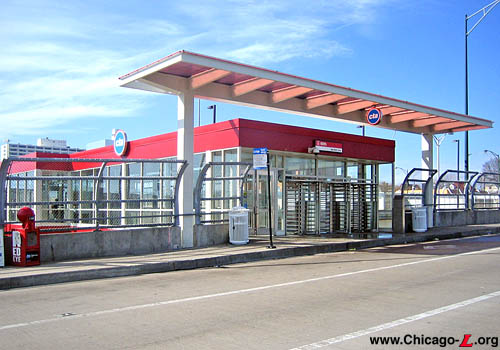
The street entrance to the
renovated 69th station is seen looking southwest on April 1,
2007. Improvements to the entrance include refurbishment of
the structure, new paint, a new "storefront" enclosing the
entranceway with doors and windows, a new "eyebrow canopy"
over the entrance to protect waiting bus passengers, and
identification signage. Note that 69th is unique among the
renovated Dan Ryan stations in incorporating exit rotogates
into its front facade. For a larger view, click
here.
(Photo by Graham
Garfield)
|
69th
(6900S/1W)
69th Street and Dan Ryan
Expressway, Greater Grand Crossing
Service
Notes:

|
Red Line: Dan Ryan |

|
Accessible
Station |

|
Owl
Service |
Quick Facts:
Address: 15 W. 69th
Street
Established: September 28, 1969
Original Line: West-South Route, Dan Ryan branch
Previous Names: n/a
|
Skip-Stop Type:
|

|
Station
|
Rebuilt: 2005-06 (renovation), 2013 (refurbished)
Status: In Use
History:
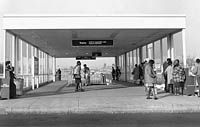
The 69th station is one of
two on the Dan Ryan Line with a bus bridge for off-street
intermodal connections. The station entrance, with its
characteristic Skidmore Modern-style glass and steel
rectilinear design, is set between the busway and 69th
Street, with stairs down to the platform-level fare
controls. The station has been open for just over a month in
this November 6, 1969 view with passengers waiting for
connecting buses. For a larger view, click here.
(Photo from CTA
Collection)
|
The design of 69th and the other eight stations of the Dan Ryan line
were carried out by Skidmore, Owings & Merrill under the
direction of Myron Goldsmith, who developed a modern, functional form
in the late International style popular at the time. Improved
visibility and security, ease of cleaning and more comfortable
working conditions for CTA employee were design goals. Skidmore took the Kennedy-Dan Ryan
("KDR") project in a unique direction, designing all aspects of the
new lines to harmonize in both shapes and materials. All windbreaks,
dividers, and ticket booths were stainless steel. The supports of the
transparent platform canopies and the structures of the station
enclosures are white-painted steel frames, and the enclosures
themselves are glass. The formal and functional criteria were
expressed in several ways: open, uncluttered, brightly lit interior
spaces; durability, safety, maximum efficiency of movement; lightness
and purity of structure. The shape of everything, from the buildings
to the agents' booths, to the trashcans, followed together into a
seamless design philosophy, which perfectly captured the boxy, purely
functional International Modern style for which Skidmore is so well
known.
The commemorative brochure published for the event describes the
stations this way:
"Nine stations serve the Dan Ryan Line...
Wide visibility and a high level of illumination are
characteristic features in all areas. Fare collection equipment
and turnstiles are stainless steel and... escalators supplement
stairs for movement between station levels. Stations in the
expressway medians are constructed of steel and glass providing
maximum visibility from adjacent streets and highways. The
boarding platforms are long enough to accommodate 8-car trains...
Steel framed canopies of translucent plastic [extend]
beyond the center line of the tracks. Self-service infrared
radiant heaters are located at windbreaks on the platforms.
Off-street bus transfer facilities are provided
at the 95th
Street terminal and at 69th
Street station by means of bus bridges
over the expressway traffic lanes."
69th station features a small "open plan" type facility with
stainless steel fare collection equipment with stairs and an
escalator leading down to the north end of an island platform. In
terms of interior arrangement and design for the passenger, Skidmore
generally followed the edict of modernist pioneer Mies van der Rohe
that ‚ "less is more." Except for at a few locations (most
notably 95th Street terminal), there were no
concessions provided for passengers. Air conditioning and a compact
washroom with a toilet were provided in the agents' booths. Restrooms
were for employees only, though payphones were provided. Stainless
steel turnstiles, now an industry standard, were first used here. The
amenities and traffic circulation fit with the architectural design
of the station: efficient but purely functional. Stations were
designed with wide walkways and no blind corners, with turnstiles and
agents booths arranged for maximum queuing and circulation
effectiveness.
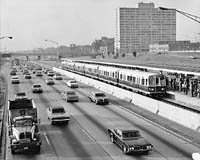
Looking south just a few
days after beginning operation, a northbound Lake-Dan Ryan
train is stopped at 69th station on October 1, 1969. The
6-car train is entirely made up of Pullman 2000-series cars.
The crowd on the platform shows how the line was
well-patronized from day one. For a larger view, click
here.
(Photo from the CTA
Collection)
|
The stations' design even formed a harmony with the 150 rapid
transit cars that were ordered to serve the new Kennedy
and Dan Ryan lines,
which used the same design philosophies and basic shapes, and an
entirely new system of signage with a redesigned typeface and clean
graphic style (still used by CTA today, in a modified form), making a fully integrated design
throughout the entire project.
Stations were spaced at between half-mile and one-mile intervals,
reflecting an increasing spacing of stations prominent in the postwar
period, with bus lines acting as feeders to the rapid transit line.
The Dan Ryan and
Kennedy stations
were also set up to allow Pay On Train operation, though without all
of the complicated gates and rearrangement built into the Congress
stations. The translucent skin of the headhouse exteriors made this
type of operation more safe than before, though not necessarily
making it more aesthetically desirable for the customer. The result
was a utilitarian white steel and glass station that is functional
but not particularly ornate.
Prepaid Bus Loading Test
Effective Monday, September 9, 2002, the
CTA began testing an
off-vehicle fare collection for buses at the 69th Street Red Line
station, with the goal of reducing bus loading times and making a
more integrated intermodal facility with the "L". In effect on
weekdays only between 1500 and 1900 hours, customers using the 69th
Bus Bridge to board buses paid their fares at turnstiles located
within the street level portion of the 69th Street station. The
bridge operated as a "paid" bus station platform. Prior to 1500 hours
and after 1900 hours, bus customers paid their fares on the bus as
usual, with fares and transfers deducted from farecards and transfer
cards in the normal manner. Customers could also pay cash fares on
the bus.
During the prepaid operation in the PM rush, bus customers paid
their fares at the bus turnstiles located in the street level station
house. Customers could use either a farecard, or a transfer card, or
a pass, as the bus turnstiles did not accept cash. After payment of
fares at the bus turnstiles, customers could board the bus without
reinserting their farecard or transfer cards in the bus farebox.
As an aid to operators and supervisors, two illuminated signs were
mounted on the bus bridge sidewalk railing and displayed a green
light and the message "Fares paid" when off vehicle fare collection
was in operation. Off vehicle fare collection was not in operation on
holidays when a Sunday schedule is in effect.
The program was canceled effective Monday, November 18, 2002. As
such, the four affected bus routes returned to normal onboard fare
collection and the bus bridge ceased to function as a paid area.
CTA indicated that the pilot program met with limited success. The
biggest problems seemed to be getting customers used to a system of
onboard fare collection acclimated to prepaid bus fare payment, as
well as difficultly effectively converting a bus bridge designed for
unrestricted access from the street to function as a
restricted-access paid area, with insufficient modification of access to the
bridge causing fare evasion problems.
The 69th Street off-vehicle bus fare collection test was billed as
a "six month experimental pilot program", but lasted only two and a
half months.
Dan Ryan Red Line
Rehabilitation Project
With few major improvements (though with a lot of patching) over
its thirty year life, by the early 21st century the Dan
Ryan Line was in need of a major overhaul. On April 3, 2003, the
Chicago Transit Board approved a $4.5 million contract to renovate
the 69th and 95/Dan
Ryan bus bridges as well as the bus turnaround at 95th Street,
signaling the beginning of the rehabilitation of the Dan Ryan branch
of the Red Line. The Dan Ryan renovation project entailed upgrading
the infrastructure of the line, including improving power reliability
and delivery of that power, and providing station improvements to the
seven stations on the branch north of the terminal.
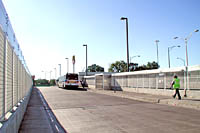
The renovated 69th Street
bus bridge is seen looking west on September 1, 2005. The
rebuilding provided new driveway and sidewalk pavement, new
high fencing with integrated bus shelters, and new lighting.
For a larger view, click here.
(Photo by Graham Garfield)
|
The bus bridge element of the project included rehabilitation of
bridge supports, replacement of the bridge deck including busway
pavement, curbs and walkways, refurbishment of barriers and fencing
on the bridge, and installation of a new lighting system. Steel
girders were cleaned and painted. The bridge and turnaround work did
not significantly affect rail or expressway traffic. Repairs to
abutments, piers, and retaining walls were minor. All improvements
conformed to the Americans with Disabilities Act (ADA).
The contract for work on this project was awarded to Chicago-based
F.H. Paschen/S.N. Nielsen & Associates through a competitive
bidding process. Work on the bus bridge and bus turnaround at 69th
and 95th streets started in Spring 2003, with
bus customers using the bus bridge at the 69th station experiencing a
temporary change of bus stop locations beginning Friday, June 27 as
the bridge closed for reconstruction. While the bus bridge was under
construction, CTA located
temporary bus stops on adjacent streets near the terminal. The
temporary stops were all within a block of the terminal so customers
did not have to walk far. Temporary bus stops were in place through
October 2003, when access to the bus bridge returned to normal.
Effective 12:01am, Friday, October 3, 2003, construction resulting
from the reconstruction of the 69th station bus bridge was completed.
Punchlist work on the bus bridge and bus turnaround at 69th continued
until November 2003. Funding for the bus bridge rehabilitation was
provided by Illinois FIRST, the Federal Transit Administration and
the Regional Transportation Authority.
On October 7, 2003, the Chicago Transit Board approved a $192.5
million contract to rehabilitate the Dan Ryan branch, with
Kiewit/Reyes, AJV (A Joint Venture) awarded the construction contract
for the remainder of the Dan Ryan Rehabilitation Project -- track and
traction power infrastructure, signals, and station renovations -- as
part of a competitive bid process. The total cost of the Dan Ryan
rehabilitation program was to be $282.6 million.
The project was executed in three phases. During the first phase
of the project, which extended from March 2004 to May 2005,
CTA replaced crossover track,
installed a temporary signal system to support the track work and
began third rail replacement from Cermak-Chinatown
to 95th. As part of Phase II, which ran
through early 2006, the CTA constructed two new substations and upgraded two existing
substations, installed a permanent signal system and replaced third
rail.

The south end of the 69th
platform shows the progress of the station rehab on
September 1, 2005. A wooden platform extension has been
added to allow for the berthing area displaced at the north
end by the temporary presence of the fare controls. In
addition, the canopy "bubbles" have been removed and the
lights are temporarily hung by chains at this end. For a
larger view, click here.
(Photo by Graham Garfield)
|
Phase III improvements, which began at the end of June 2005,
consisted primarily of station renovations. Work at the seven
stations located between Sox-35th and
87th included refurbishing platform
canopies, architectural components, escalators, the existing station
house, and new platform floor finishes, enhanced lighting, new
customer assistant kiosks and improved signs. Eight escalators along
the branch were replaced and new elevators were installed at
47th and 69th,
making those stations accessible to customers with disabilities.
There were also enhancements to improve bus connections, such as curb
cuts, canopies over station entrances and improved lighting on the
approach to each station.
69th station remained open throughout the renovation project. Much
of the work was done under single track operations during midday,
owl, and other off-peak hours to allow contractors Kiewit/Reyes,
Aldridge Electric, and others to undertake renovation work. On many
days, it was also common for half of the platform at a time to be
taken out of service at certain stations during owl hours to provide
unobstructed access to the contractors. During some periods, trains
in excess of four cars in length were prohibited from stopping at
certain stations also to provide contractor access.
Work at 69th began in mid-August 2005, when on August 12 the train
berthings were moved south to allow for the fare controls to be
shifted further south on the platform. To allow this to occur, a
temporary wooden platform extension, including a wooden windbreak and
a few freestanding lights, was placed in service on the south end of
the island platform to extend it by about a car length. Shortly
afterward, work began on constructing wooden side enclosures around
the new fare control area at the north end of the platform and on
temporary stairs up from this area to the south side of the bus
bridge. Also during August 2005, work began on removing the old
plexiglas canopy roof "bubbles" so that the canopy structure could be
refurbished. Work also began at the south end of the platform on
removing the original terrazzo flooring so that the new concrete
floor could be installed.
On Wednesday, August 31, 2005 at 0001 hours, the main entrance in
the station house between 69th Street and the bus bridge was closed
so that the contractor, Kiewit/Reyes, could renovate it, including
the installation of an elevator and the relocation of the fare
controls from the platform to the street-level building. The
concession stand inside the headhouse remained open for a short time
after entry to the platform was closed, accessible from the south
doors at the bus bridge and closed off from the rest of the station
house by means of plywood walls. While the renovation work in the
station house was in progress a temporary stairway located on the
south side of the bus bridge, across from the existing station house,
provided access to the 69th station platform. The stairway connected
to the bus bridge across from the station building and was connected
by removing three fence panels and part of the concrete wall on the
bridge.
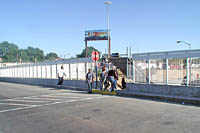
To allow for its renovation,
the station house was closed on August 31, 2005 and entrance
to the platform was provided by means of a temporary
staircase. Seen looking southeast on September 1, 2005, the
temporary stairs connect to the south side of the bus bridge
by the removal of three railing panels and some of the
concrete wall. For a larger view, click here.
(Photo by Graham Garfield)
|
During Autumn 2005, the original terrazzo platform flooring was
removed from the remaining station platform. By the end of Fall, the
new concrete flooring was completed. Bases and supports for new steel
windbreaks were set in the new platform flooring; the framework for
the new enclosures installed by the end of the year. In the meantime,
temporary wooden windbreaks were installed to provide some shielding
from the winter winds. The street-level station house was completely
gutted during Autumn, including the flooring and all of the vertical
access elements.
Work continued at 69th throughout Winter 2006-07 and Spring 2006.
The second of two "linecuts" was performed over Memorial Day weekend,
when service was temporarily suspended in both directions between
95th/Dan Ryan and 63rd
stations from midnight Friday, May 26 until midday Monday, May 29,
with a shuttle bus in between. Work included painting the canopy
columns and station exteriors and track and tie renewal at several
locations. During both linecuts, stations were covered with large
tent-like enclosures to protect workers and keep materials and dust
contained.
By August 2006, new skylight canopy domes were being installed at
all stations from Sox-35th to 87th.
Progress was made on the installation of new vertical access elements
during summer, with steel erection and construction of the new stairs
at 69th completed by August. Construction of the new elevators at
47th and 69th stations continued through
the end of summer.
Effective at 8am, Saturday, October 21, 2006, the 69th station
house reopened while construction continued. The temporary stairway
located on the south side of the bus bridge was closed and
subsequently removed. The station house now housed the fare controls
and Customer Assistant booth in the south half of the building.
Plywood walls channeled passengers through the building while some of
the permanent barriers were still being erected.
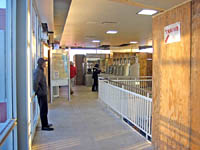
This November 1, 2006 view
looking south inside the 69th station house shows that the
fare controls had been relocated to street-level but work
was continuing within the facility. For a larger view, click
here.
(Photo by Graham Garfield)
|
By mid-November 2006, installation of new station platform canopy
skylight "bubbles" was substantially complete at all stations in the
project zone, from Sox-35th to 87th,
inclusive. Installation of new escalators was continuing at 69th
station. Work also continued on the new elevators at 47th
and 69th and on renovating the existing elevator at 79th.
The new escalators at 69th station entered service on Thursday,
December 28, 2006
During November, work also continued on the installation of
platform amenities at all stations, painting station house exteriors
and platforms, installation of new light fixtures on platforms,
installation of new lighting and ceilings in station houses, and
installation of new signage.
By the end of 2006, the renovation of 69th station
was substantially complete with only punchlist work remaining. The
finished station included the improvements listed above and, much
like the original Kennedy-Dan Ryan project design by Skidmore,
introduced several elements now standard at Dan Ryan stations (minus
95th/Dan Ryan and Cermak-Chinatown,
which were not part of the project) including a new type of Customer
Assistant booth (now also used in the renovated Brown
Line stations), windbreak, and combination bench/sandbox. The
station house and platform canopy received red bands as part of its
new paint scheme, providing some color to the facility's exterior as
well as line identification.
The north entrance on the street side of the 69th
station house received a new white-painted steel "eyebrow canopy"
over the front of the station house to protect passengers waiting to
transfer to eastbound #69 69th buses. The canopy, a modern design
somewhat reminiscent of a scaled-down version of the crosswalk
covering installed at Sox-35th in
2002-03, includes 10 art glass panels in its roofing. The red-tinted
images are of the original construction of the 69th station canopy
and platform and nearby track circa 1969. The images are installed at
one of four different angles arranged randomly.
Also included as part of the graphics package were station name
signs mounted outside the tracks on the expressway sidewall, facing
the platform. These types of "outside" station name signs were
previous seen primarily at ADA-accessible stations, although they
were installed at all renovated Dan Ryan stations including those
without elevators. The frames on which these signs were mounted
included a feature unseen before: a stainless steel panel between the
posts on the back of which was mounted an extruded resin
CTA logo facing the
expressway. This was one of several ways the new (as of 2004)
CTA logo was incorporated into
the renovated Dan Ryan stations. The logo was also mounted along the
cornice of all the station houses (typically at the rear end of the
side elevation with with half of the shield extending above the
roofline) and was applied as a hanging station "identifier"
underneath the eyebrow canopy as the stations that received these
coverings.
Effective January 3, 2007, 69th station's elevator elevator was
put in service, making the station ADA-compliant and accessible for
customers.
Red Line South Reconstruction Project
In 2013, the CTA launched the Red Line South Reconstruction Project, a track renewal project to rebuild the Dan Ryan branch tracks from the bottom up, excavating down to the bottom of the trackbed to rebuild the underground drainage system then installing new ballast, ties, and tracks.
In order to perform the work more quickly and cost-effectively, the CTA closed the Dan Ryan branch for five months while work was performed. During that time, there was no 'L' service on the Dan Ryan branch south of Roosevelt station. Red Line trains were rerouted via the old 13th Street Incline from the State Street Subway to the South Side Elevated, where they operated to Ashland/63rd via the South Side Elevated tracks in a pattern reminiscent of the old Howard-Englewood "A" trains of the North-South Route days. Red Line service to Ashland/63rd began on Sunday, May 19, 2013. Following the five-month track reconstruction and renovation work on the Dan Ryan, Red Line service to 95th resumed at 4am, Sunday, October 20, 2013.
The five-month construction option saved $75 million over an option to perform work on weekends only. CTA invested that $75 million savings into station upgrades along the south Red Line, including lighting improvements, painting, new roofs and canopies at some stations, electrical substation work, and other improvements. In addition, elevators were added to the 87th, 63rd, and Garfield stations, making the whole Dan Ryan branch, and indeed all "L" stations on the whole South Side, accessible.
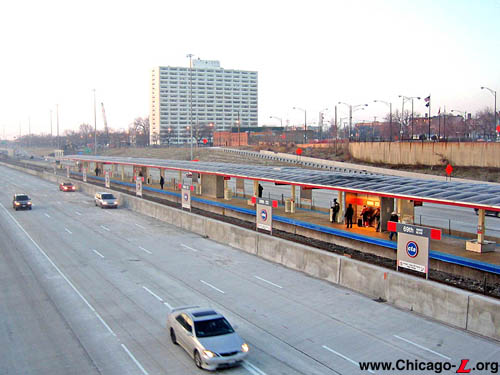
This view of the renovated
69th station looking southwest from the bus bridge over the
Dan Ryan Expressway on December 24, 2006 shows several
elements from the rehabilitation project, including new
canopy skylights, new signage, and the refurbished,
repainted station canopy structure. For a larger view, click
here.
(Photo by Graham
Garfield)
|
 69th Station
(1969-2003) |
Dan Ryan
Renovation (2004-present)
69th Station
(1969-2003) |
Dan Ryan
Renovation (2004-present)
69th Station
(1969-2003)
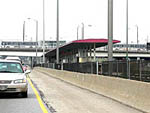
|
69th01.jpg
(124k)
The 69th Street station, looking north from the Dan Ryan
Expressway on July 28, 2001. Like all Dan Ryan stations, the
island platform leads to a square, utilitarian, modern
glass-and-steel station house at street level. Unlike most
Dan Ryan station (except 95/Dan
Ryan), the stations leads to a bus bridge, specially
made for transfer to CTA sub routes (as evidenced by the CTA
buses lined up across the bridge). (Photo by
Graham Garfield)
|
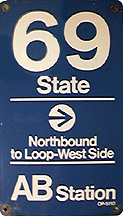
|
69thSign.jpg
(21k)
A 69th Street KDR-type station column sign.
(Sign from the collection of Graham
Garfield)
|
Dan Ryan
Renovation
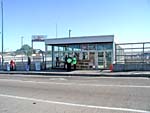
|
69th05.jpg
(155k)
To allow for its renovation, including the
installation of an elevator and the relocation of the fare
controls, the 69th station house was closed on August 31,
2005. The doors were locked and signs, both
professionally-made and homemade, were placed on the front
entrance directing passengers to the temporary entrance on
the bus bridge. Seen looking south on September 1, 2005, a
rail supervisor has joined the usually-assigned bus
supervisor to help direct acclimating customers on the
second day of the service change. (Photo by
Graham Garfield)
|
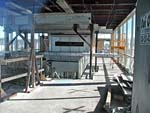
|
69th06.jpg
(172k)
Just one day after the station house closed,
construction contractors have already set to work inside the
69th station house, seen looking south through the doors
from outside the building on September 1, 2005. Changes to
the station house will include new flooring, the
installation of an elevator for ADA accessibility, and the
relocation of the fare controls from the platform up to this
street-level facility. (Photo by Graham
Garfield)
|
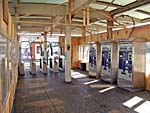
|
69th08.jpg
(198k)
While the 69th station house is under renovation, the
fare controls have temporarily been relocated to the north
end of the platform, seen here looking south in the unpaid
area on September 1, 2005. (Photo by Graham
Garfield)
|
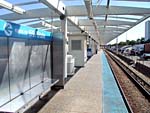
|
69th09.jpg
(194k)
The 69th station platform is under renovation, seen
here looking south at its midpoint on September 1, 2005. At
this point on the platform the plexiglas "bubbles" in the
canopy have been removed for refurbishment and the lights
have been temporarily hung from chains while the steel
canopy structure is being renovated, but the terrazzo
platform has not yet been removed, nor has the original
stainless steel windbreak. But that will come soon.
(Photo by Graham Garfield)
|
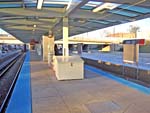
|
69th11.jpg
(143k)
This view looking north on the 69th station platform on
November 1, 2006 shows several elements from the station's
renovation, including new concrete flooring, refurbished
canopy structure and new skylight "bubbles", new stainless
steel windbreaks, and new signage (still being installed).
Some elements are still yet to be installed.
(Photo by Graham Garfield)
|
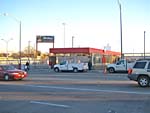
|
69th12.jpg
(129k)
The refurbished 69th station house, seen looking
southeast on November 1, 2006, incorporated a number of
identification elements, including red banding to aid in
line identification and large
CTA logos mounted
along the cornice of the station house, with half of the
shield extending above the roofline. Work was still underway
at the time of the photo, however, with interior barrier
elements and the stainless steel "storefront" yet to be
installed. (Photo by Graham
Garfield)
|
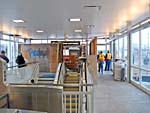
|
69th14.jpg
(149k)
The interior of the 69th station house is nearing
completion in this view looking north on November 1, 2006.
The new concrete flooring and most of the new ceiling panels
have been installed and the fare controls have been
relocated to the left and behind the photographer. However,
work continued on the escalator and storefront, the elevator
(out of view behind the photographer) and the plywood walls
temporarily channel traffic until permanent barriers are
installed. (Photo by Victor
Ramirez)
|
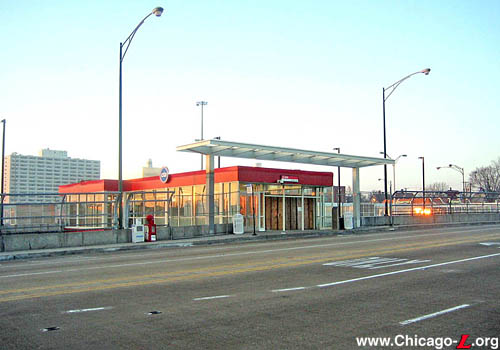
|
69th15.jpg
(132k)
The refurbished 69th station house, seen looking
southeast on December 24, 2006, is nearly complete but work
was still underway at the time of the photo. Interior
barrier elements and the stainless steel "storefront" with
exit rotogates were still yet to be installed.
(Photo by Graham Garfield)
|




















